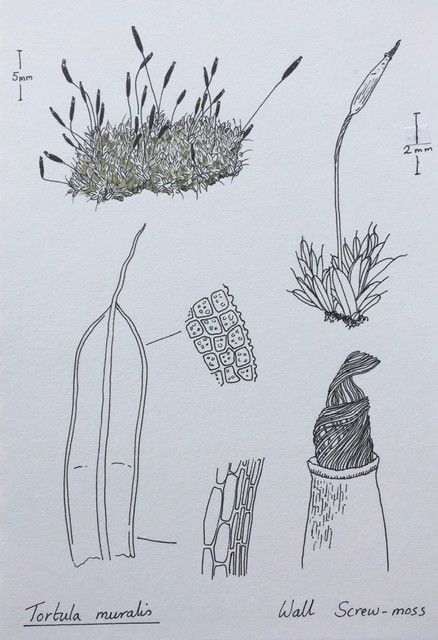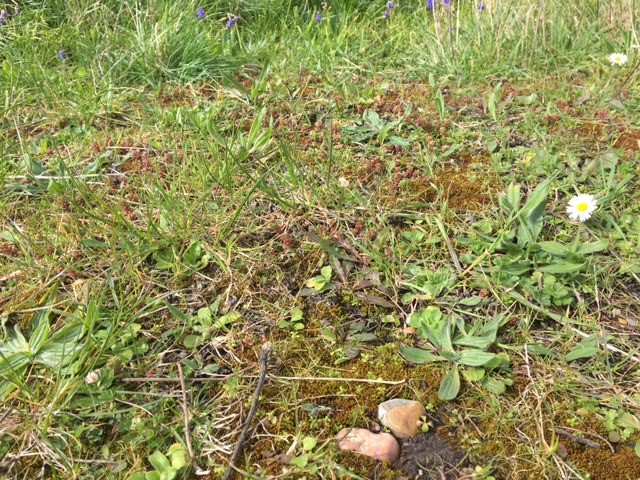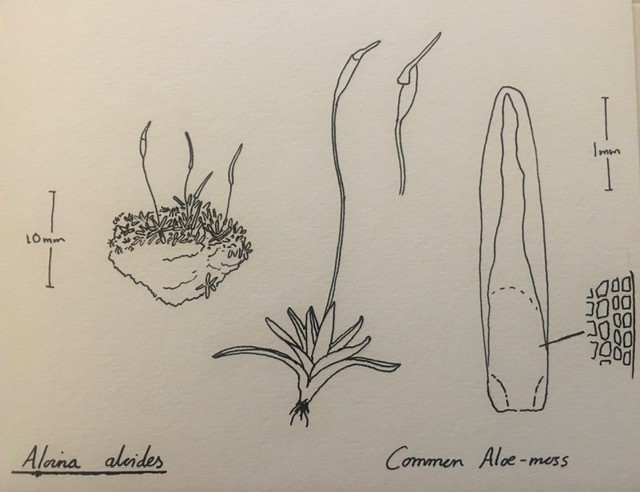It’s almost three months since I visited Amberley Museum which is nestled in a chalk pit in the riverside village of Amberley and is dedicated to preserving the industrial heritage of the South East. It is one of those brilliant places that I feel slightly ashamed not to have visited before and wonder why I never took the children when they were little!
It was a treat to explore the site on a day closed to visitors but busy with museum staff, builders and volunteers. It was also useful bryo work as there were no previous records from the museum grounds which straddles two under-recorded tetrads. Previous records were nearly all from ditches on the flat lands around the river Arun: Riccia fluitans from 1984,1998 and 2017 and a number of colonies located by Francis Abraham who scoured the ditches in 1997. There is a record made by Howard in 1990 for Calliergon giganteum on the brooks near the castle which should be checked for again as it has only been seen in four locations in Sussex and there are no recent records..
Chalk pit finds promised to be quite different.
I started off by climbing a hill which skirts a large chalk pit in the south-east corner up to a view point. The path followed a narrow strip of humid Ash woodland. These large Ash trees were a good habitat for epiphytes with Amblystegium serpens, Radula complanata and Zygodon conoideus. A Silver Birch was nice too with Homalothecium sericeum, Pulvigera lyellii and Ulota bruchii. One large Birch and an Ash were host to Anomodon viticulosus but sadly the poorly Ash had been felled leaving a table-height stump. Cirriphyllum crassinervium grew on the base of Silver Birch and on wooden step risers. On the ground beneath the trees a small patch of Cirriphyllum piliferum grew among more common woodland mosses. This bright-tipped feather-moss never seems to grow in abundance.
Emerging at the top, mosses of chalk grassland took over with swathes of Homalothecium lutescens growing with Pseudoscleropodium purum and Calliergonella cuspidata. On bare chalk the little mosses Dicranella howei and Didymodon fallax grew with the tiny leafy liverwort Mesoptychia turbinata.
A bank of Primroses was cushioned by the dull, bouncy shoots of Eurhynchium striatum.
Back down among the museum buildings; walls, tracks and paving were an excellent place to look for bryophytes of man made habitats. Grimmia pulvinata and Tortula muralis on brick walls, Syntrichia montana in gaps in paving and Didymodon insulanus and Cratoneuron filicinum at the edge of grassy areas.

I took the nature trail walk which led towards the big curve of bare chalk at the other end of the museum. In the rather ordinary woodland a huge fallen Sycamore was wrapped in Cirriphyllum crassinervium and Cryphaea heteromalla and Thamnobryum alopecurum and Eurhynchium striatum covered the woodland floor. Then Arthur’s copse was more of a treat with the chalk grassland specialist Campylium protensum amongst the thick mossy carpet. I crossed a railway bridge back to the museum buildings with a photo of girl guides who helped build it.
Two volunteers were having a tea break by the De Witt Kilns and helped me dislodge some Schistidium crassipilum from a clay tile roof. There were ponds and shaded old stonework where Pellia endiviifolia grew on damp stone and Rhynchostegiella tenella on a dry wall.

Then I finished off with the far chalk pit, after getting permission from the train drivers to walk along the narrow gauge rail tracks with the warning that there might be a test drive going past. It was a dry day and Aloina aloides was hard to make out on exposed chalk. The dark red, curled up leaves of dry plants are small but distinctive. I must have missed some other things as it was the tail end of chalk bryophyte season.

A steep north-facing slope was still damp and a struggle to get to through prickly scrub. I reached some Seligeria calycina on chalk, ducking under Plenogemma phyllantha and Pulvigera lyellii on a Wayfaring Tree.
Some nice chalk specialists were found and tetrad TQ01G now has 78 taxa recorded. TQ01F now has 53 taxa recorded from a low start and can turn green.
Many thanks to Louisa and all the people at Amberley Museum for the warm welcome.
